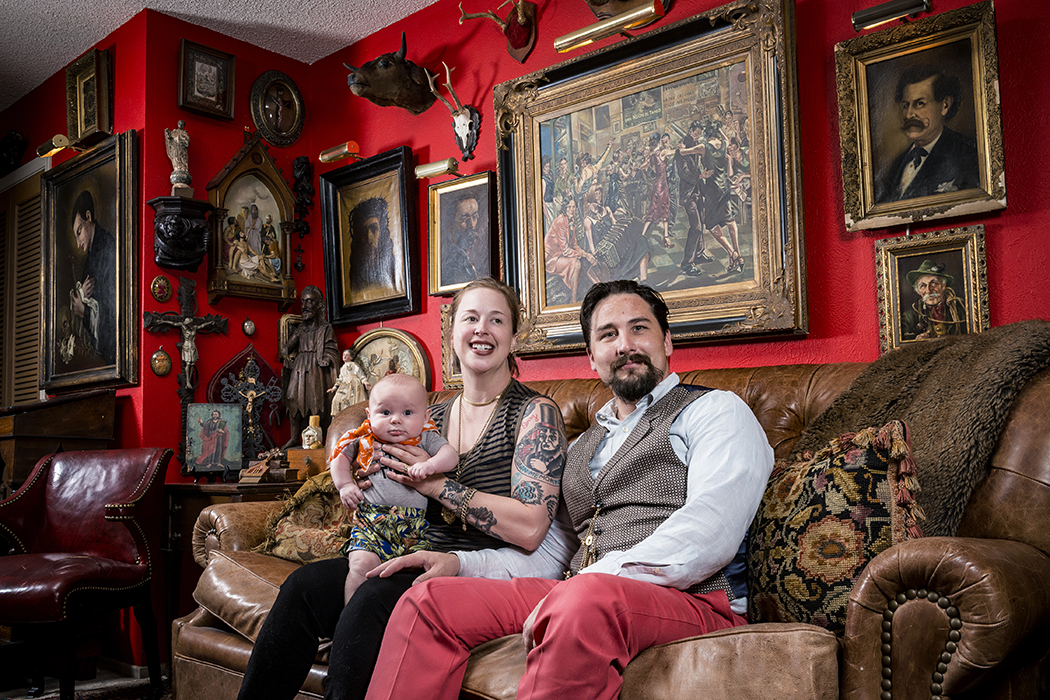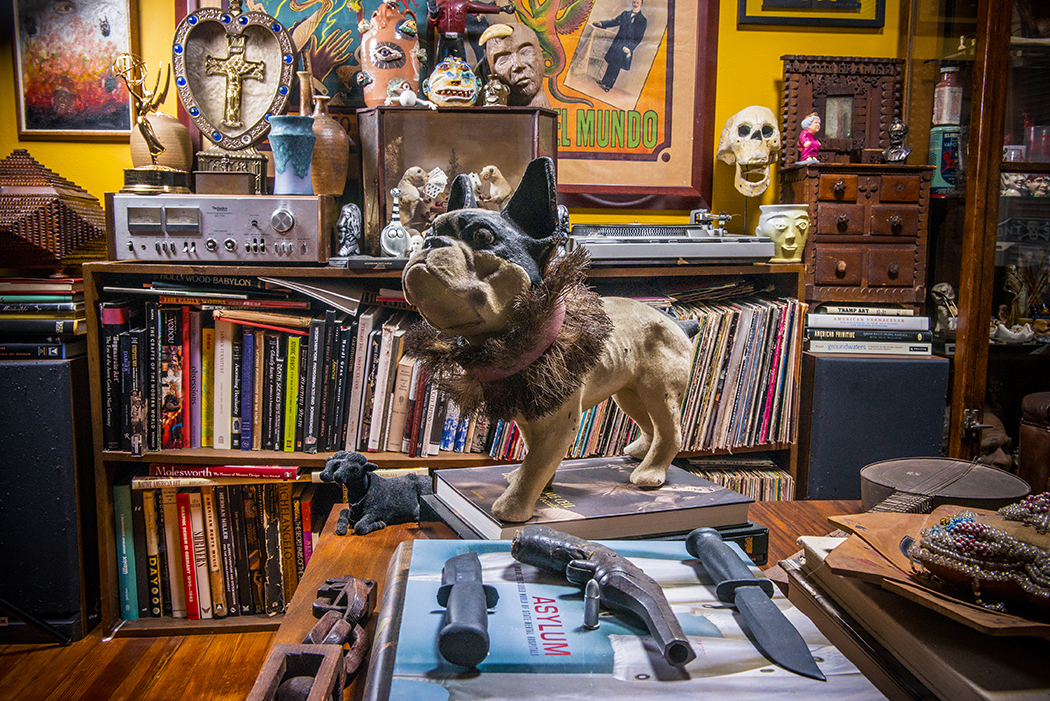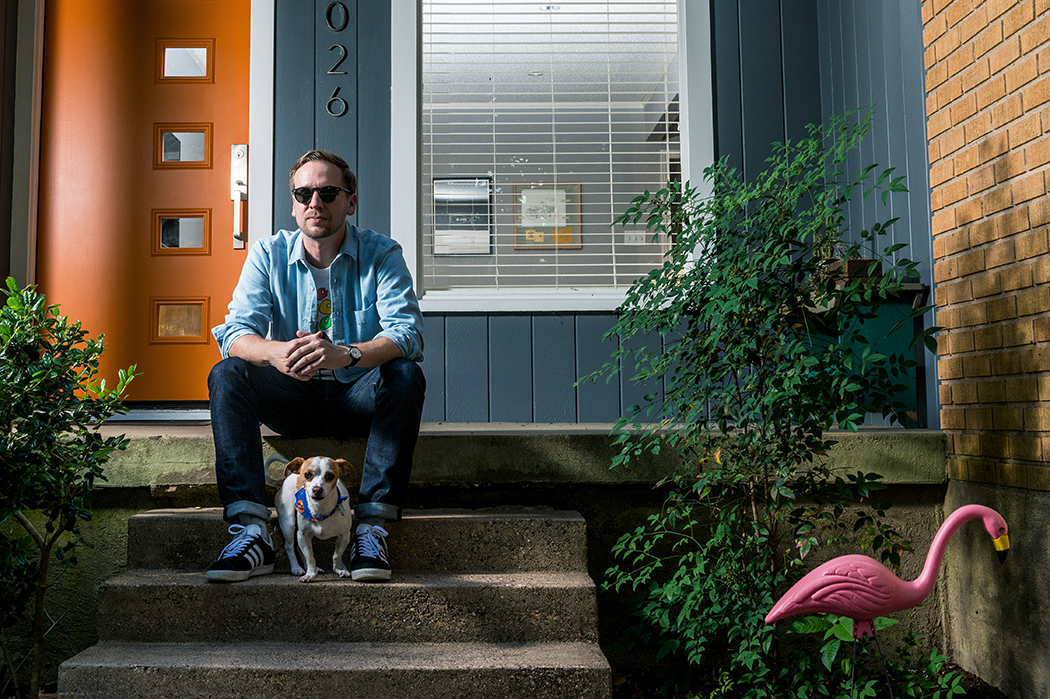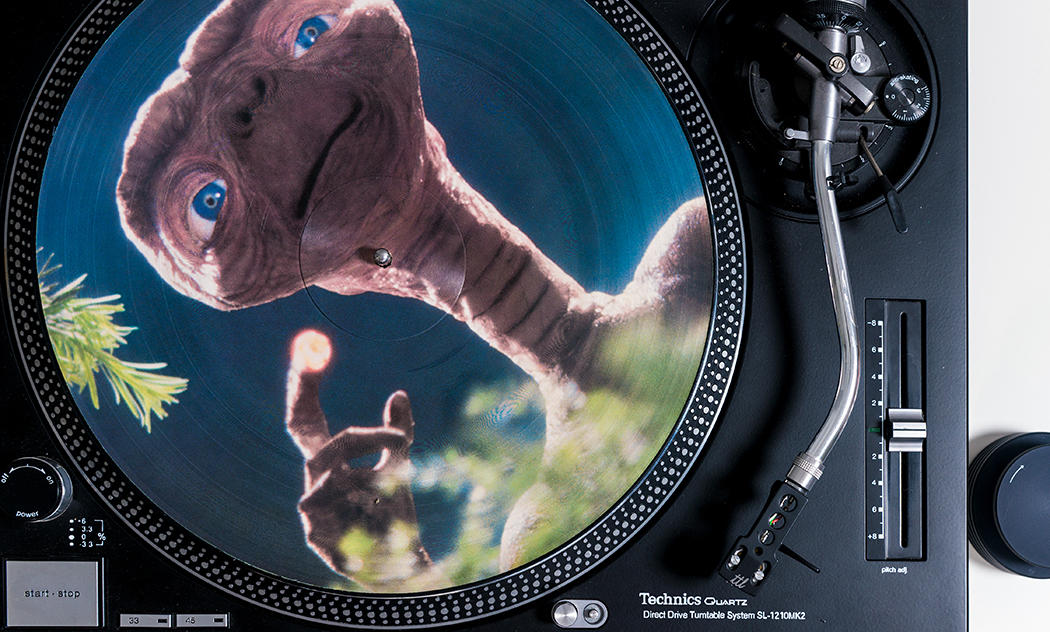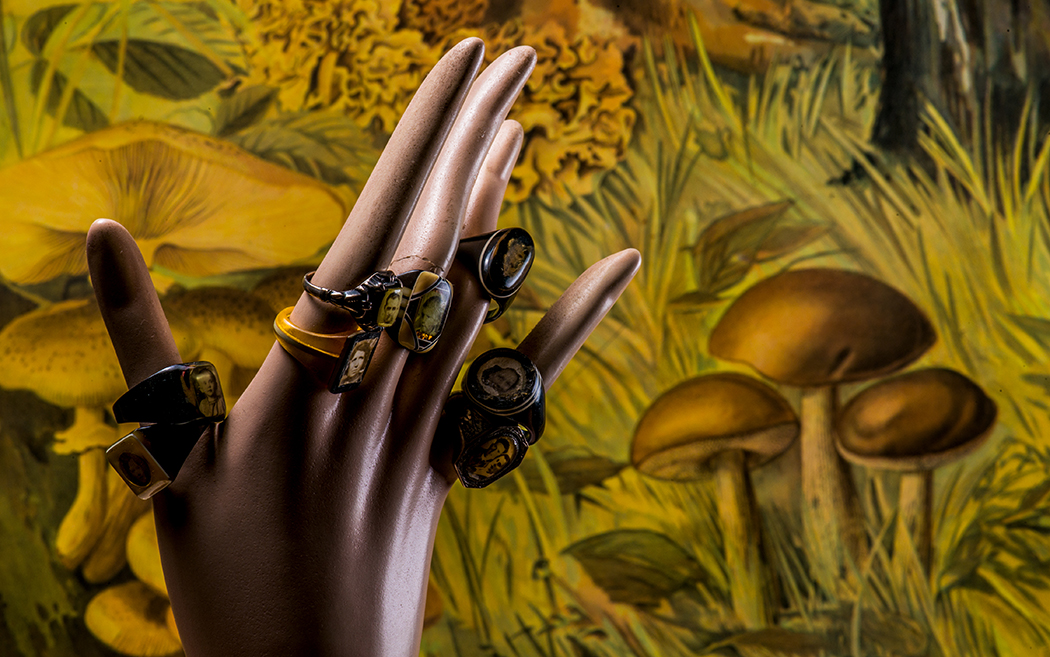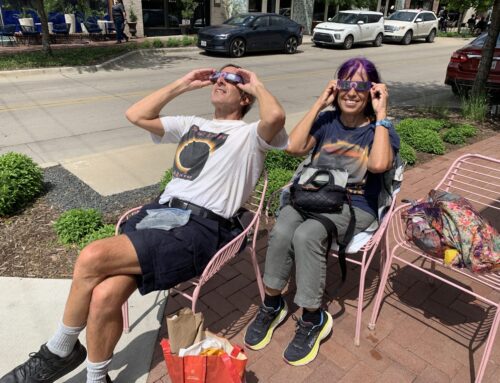Marie Kondo’s 2014 book “The Life-Changing Magic of Tidying Up” taught many Americans how to keep their homes neat like the Japanese, how to let go of things and declutter one’s life.
But accumulating stuff is part of life. And treasure hunting can be exhilarating.
It’s not easy to strike a balance between tidy and expressive.
There is a fine line between hoarding and hobby, but these Oak Cliff residents only select the best, and they take curating their collections to the next level.
Antiques in the family
What does one buy for the couple who has everything?
When Gretchen Bell and Benny Hinkle got married earlier this year, one friend gave them a human femur bone, which Inuits in the 1800s used to club hunting prey.
We’re sure a nice picture frame would’ve been fine, but it was the perfect gift for this couple, whose lives revolve around antiques.
Bell opened Dolly Python boutique in East Dallas 12 years ago. The shop is known for vintage clothes and cowboy boots as well as its antique-mall style booths from dealers with unusual taste. Her husband, who worked at the White Elephant for 18 years, opened his own shop, Benny Jack Antiques, in a space adjacent to Dolly Python last year.
They live in a two-story house near Kiest Park that is packed with treasures.
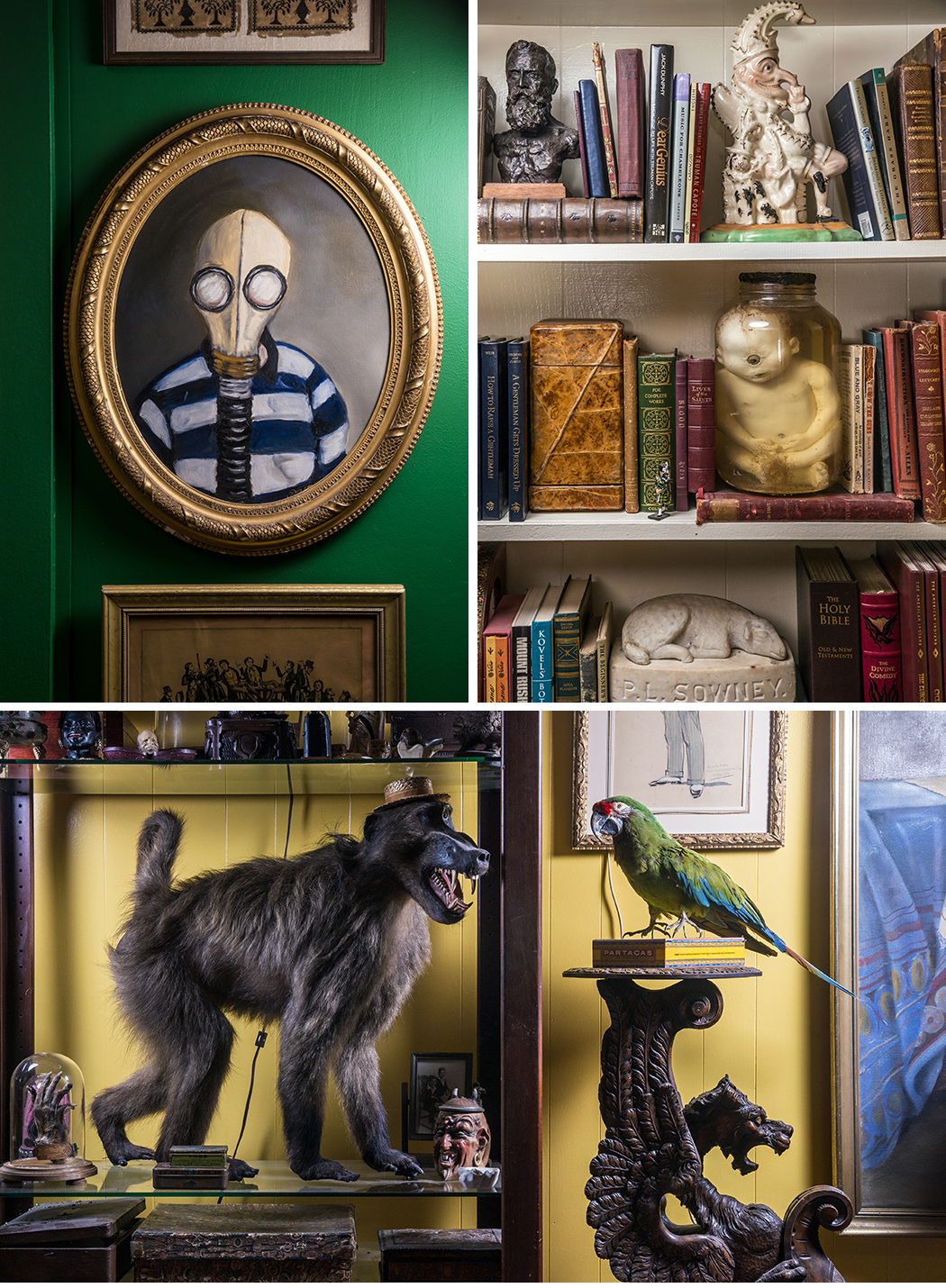
Clockwise from top right: Shelves in the Bell-Hinkle home showcase possessions, including Bell’s “cyclops baby” in a jar, a carnival sideshow prop. Hinkle and Bell have collected enough antique taxidermy to stock a natural history museum. Hinkle has been collecting paintings for many years, and he has an eye for arranging them. (Photos by Danny Fulgencio)
The Hinkle-Bells are not minimalists. Every available space on their walls, shelves and side tables are filled with things to draw you in. It’s an astounding amount of stuff, but it’s all put together just so, like a very homey museum.
The front room, with its crimson walls, is a gallery of striking 19th- and 20th-century paintings that Hinkle has collected over the years.
There’s also a zoo of antique taxidermy — a pheasant, a white crane and a baboon, among many others.
Bell started in the business at 19, hitting Dallas estate sales with the classified ads and a Mapsco. She worked at the bygone Ahab Bowen vintage clothing store in Turtle Creek for many years and also worked a second job as an assistant clothing stylist to fund the opening of Dolly Python at age 30.
She collects an overwhelming number of fascinating things, including Fred Harvey railroad jewelry. Harvey was an entrepreneur who opened a string of cafes at railroad depots in the 1800s American West. Those cafes were among the first to sell Native American jewelry to tourists.
She collects “naugahyde monsters” for her 4-month-old son, Furious. They’re dolls that were made in the 1960s to promote the fake-leather naugahyde furniture, and they can sell on eBay for hundreds of dollars.
It took months earlier this year for Bell to pack up and move out of the East Dallas house where she’d lived for more than 10 years. She says it was a painful and deeply personal process of deciding what to keep and what to let go.
Now she has a woman cave in a basement room of the house Hinkle bought four years ago.
In her room, there are nude paintings from the 1940s, handcrafted cowboy boots, 1950s mug shots from the Tarrant County jail, a collection of murderers’ rap sheets from New Orleans, a three-dimensional handmade map of the Americas and pounds of thunderbird jewelry, just to scratch the surface.
“Our style is very different, but we compliment each other,” Bell says. “Our shops are the same way. They reflect our personalities.”
Hinkle and Bell knew each other for many years before they started hanging out a few years ago. On their first date, she gave him a double leopard claw fob for the pocket watch chain that he always wears.
“I could never date someone who was not in this business,” she says. “It’s hard for people to understand what we do.”
When we visited their home in July, Hinkle’s latest acquisition was a taxidermy flying fish.
“I’d never seen one before; that’s why I wanted it,” he says. “That’s always what I’m looking for. Something I’ve never seen.”
Stranger things
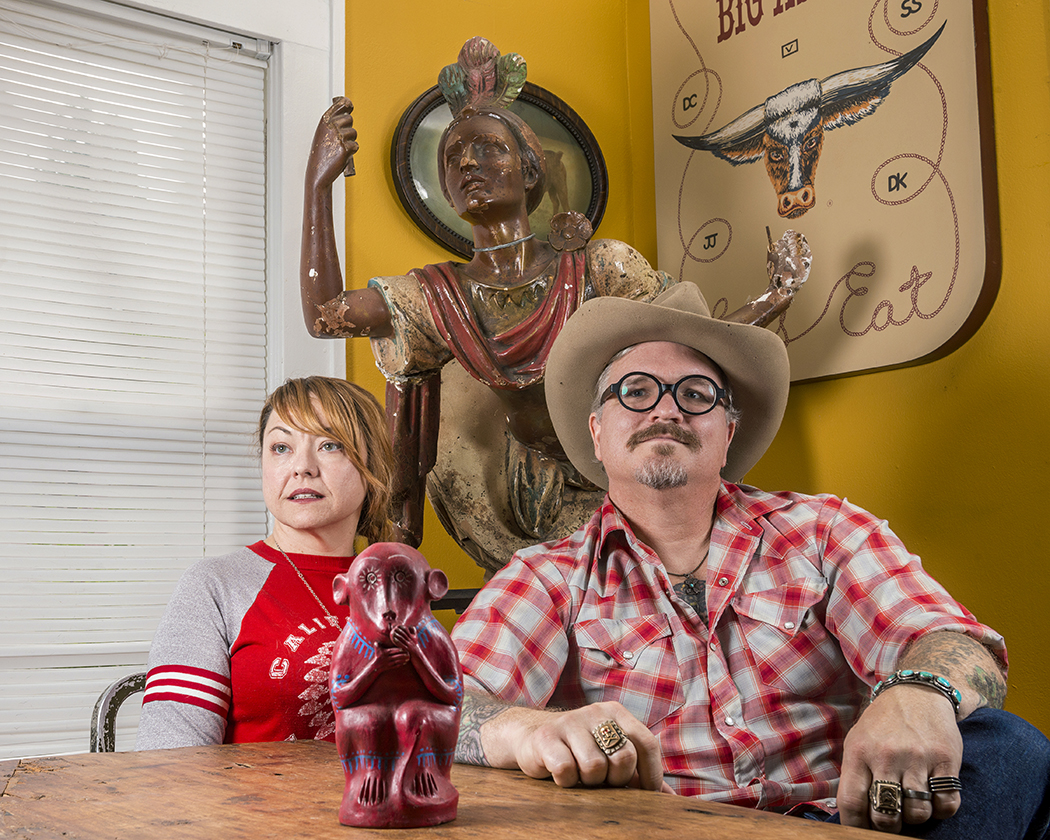
Shad Kvetko, right, is a second-generation antiques dealer who collects Mexican folk art, among many other things. His wife, Leigh, is a graphic designer who collects shoes from the 1940s. (Photo by Danny Fulgencio)
Shad Kvetko sold his prized possession, a genuine human shrunken head, earlier this year.
A longtime collector of strange things including antique funeral items and sideshow oddities, he’d searched for a real shrunken head for years — they can fetch up to $20,000. But he sold it to help fund a business venture.
Kvetko, his wife, Leigh, and their partners last month opened a mezcal bar in Exposition Park called Las Almas Rotas, “the broken souls.”
Mezcal is the latest obsession of Kvetko, a second-generation antiques dealer.
As a youngster, he collected “anything with skulls” because he thought it was punk rock. Later he got into Victorian-era funeral objects, including an embalming table and human-hair wreaths, and then carnivals and sideshows.
The Phoenix native at one time had a working sideshow with “things in jars” and strange taxidermy, such as a two-headed calf. He also owned a Mexican folk-art store in his hometown, called Saints and Sinners.
Mezcal, and the art and ephemera surrounding it, is a big part of his adoration for Mexican folk art.
“In Oaxaca, it’s all very connected,” he says. “In the mezcalerías, you see the work of local artists. That’s all part of it.”
Kvetko’s antiques collection now includes many hand-carved wooden mezcal bottles from the 1940s and ’50s.
“They’re extremely hard to find in Mexico,” he says.
Las Almas Rotas sprang out of a private club that Kvetko opened with buddies in Oak Cliff a couple of years ago — it was just a space for friends to hang out. They had a hard time dealing with liquor laws in Oak Cliff, so they opened the official bar on Parry Avenue, in the old Bar of Soap space.
Inside, you’ll find many varieties of mezcal, of course.
Plus there are a few weird things, including a 5-foot-tall St. Jude statue with glass eyes that seem to judge one’s every move. On the bar is a small, mummified monkey in a glass case.
That one Kvetko received as a gift from a santero in Oaxaca; there’s no way he could sell it.
Go, DJ. That’s my DJ
Think of any full-length album or single from 1990s rap music.
No matter how obscure or rare, Will Rhoten, the Oak Cliff resident known as DJ Sober, certainly had it in his collection.
“There was a lot of stuff that I hadn’t played in years,” he says.
He has most of them as digital files anyway. And any time he plays all-vinyl sets, he spins disco, boogie and R&B, mostly.
So earlier this year, he held a pop-up sale in Deep Ellum and unloaded about 550 hip-hop records. There are another 1,000 or so that he plans to put in another sale.
The most rare, including Diamond D’s “Stunts Blunts and Hip Hop,” brought in around $200.
At one time, Rhoten’s record collection numbered around 5,000. Now it’s just about 2,000 deep.
“I don’t regret it at all,” Rhoten says of the sale at Off The Record.
Seeing crate-diggers find the treasures of their lifetimes was worth it, he says. He met a guy from Spain at the Belmont Hotel who came to the sale, paid $200 for the Digable Planets’ “Blowout Comb” and was thrilled with the acquisition.
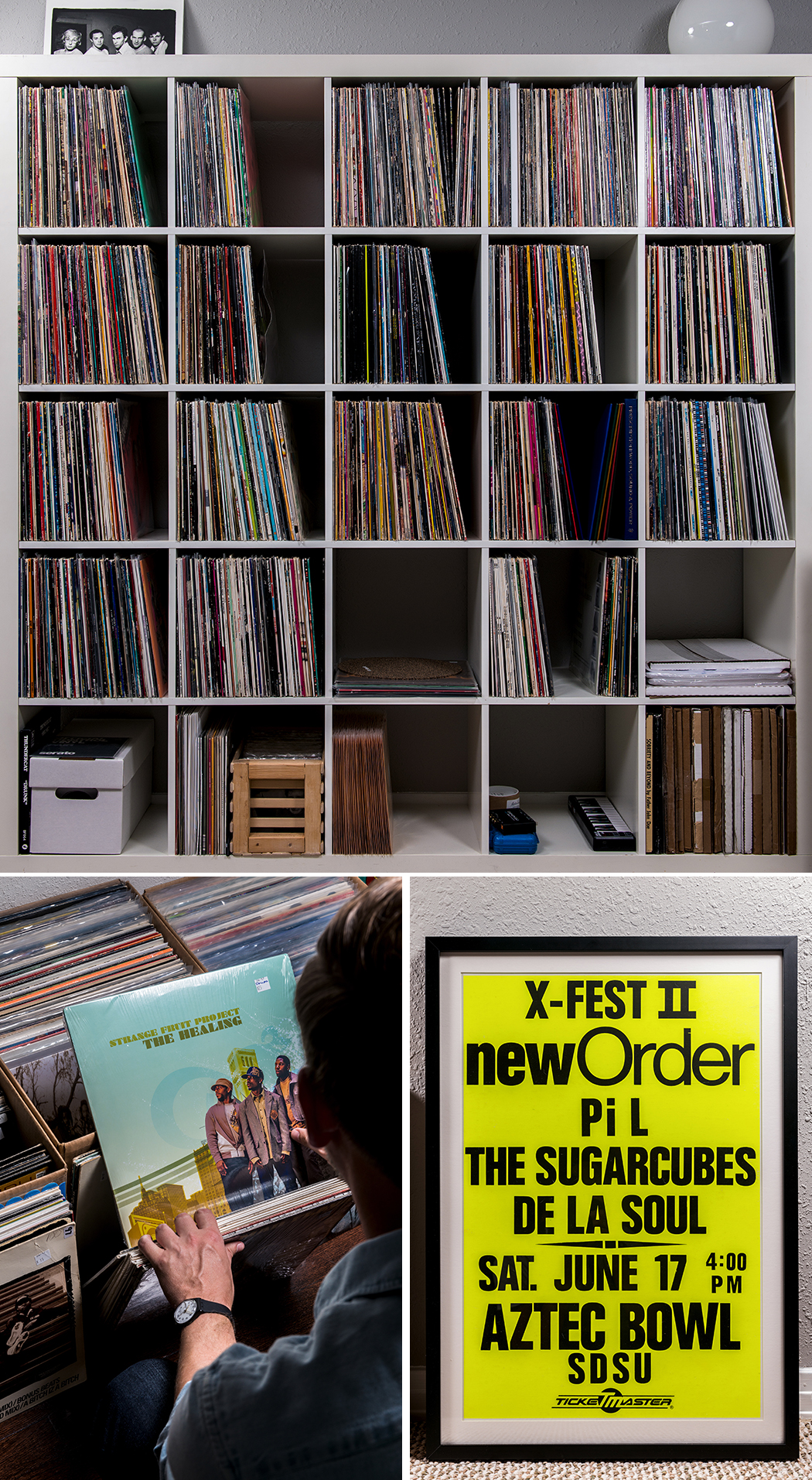
Above: Part of Will Rhoten’s vast record collection. Rhoten, known as DJ Sober, recently began selling the bulk of his hip-hop albums. Below: An “E.T.” slipmat given to Rhoten by a friend. (Photos by Danny Fulgencio)
Rhoten learned to blend house-music tracks in the early 1990s growing up in Fort Worth and going to raves. He later started mixing hip-hop records, and rap music remains his claim to fame in Dallas, where he hosts the weekly Big Bang Thursdays at Beauty Bar on North Henderson Avenue.
He was the third member of Dallas rap group A.Dd+, and he’s been the opener for Erykah Badu’s birthday party, toured nationally with Black Milk and opened for the Flaming Lips and Cut Copy, to name a few. He regularly books gigs in other cities.
Elsewhere, he’s known for specializing in Texas music. During a recent appearance on DASH radio in New York, he played a 30-minute set entirely of Dallas hip-hop.
Asked about his favorite career accomplishments, he says: “To be deeply rooted in Dallas and the scene here and to have a great local following.”
Rhoten quit his job planning events for Red Bull in 2006 and has made a good living for himself as a DJ since then. He bought a house in Elmwood about 10 years ago.
Freeing up space in the collection brought new enthusiasm for record shopping, he says. In hindsight, he wishes he’d amassed more Bjork records, which now sell for hundreds of dollars. And being a collector, he doesn’t want the reissue.
He cherishes his Smiths albums, which are rare and have cool art. He’s got just about every album and 45 put out by Sade and Prince.
“You always are filling in the gaps,” he says. “I’m more selective now.”
Rings for remembrance
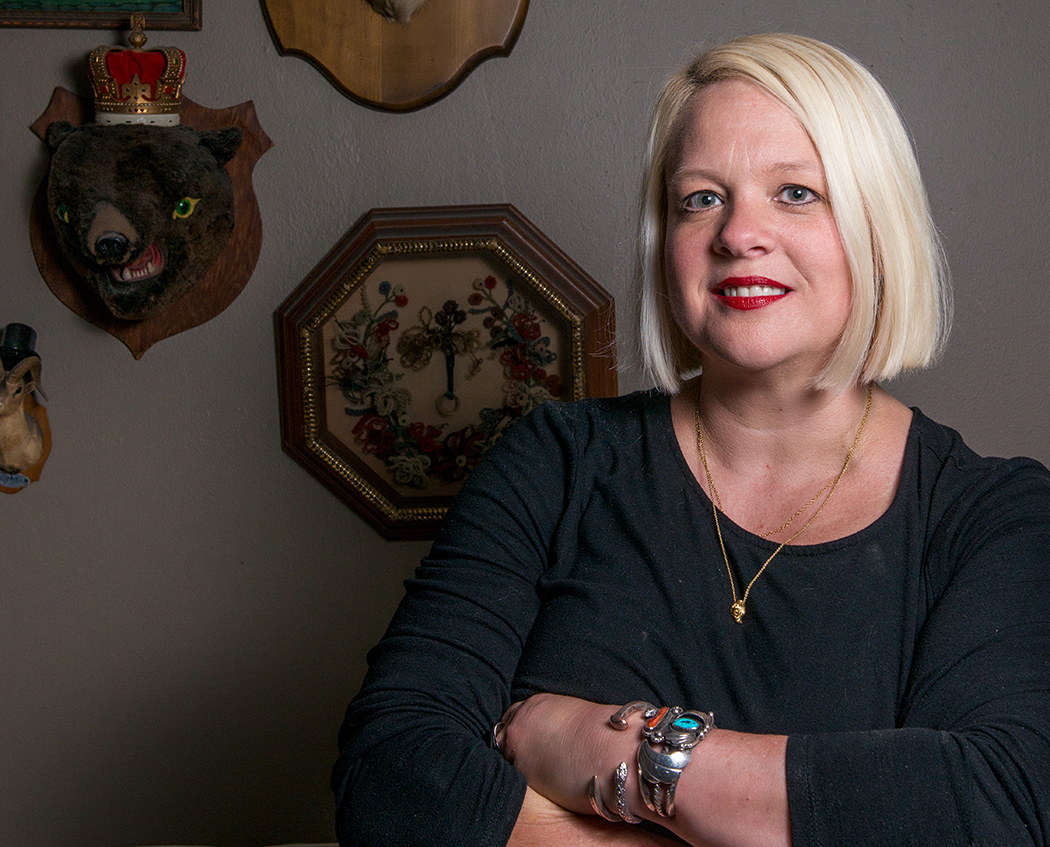
Amy Strickland began collecting jewelry after becoming “obsessed” with mourning rings. (Photo by Danny Fulgencio)
For years Amy Strickland rarely wore jewelry.
Considering her heavily ringed fingers and ever-present jangle of bracelets, that’s hard to believe now.
The Oak Cliff resident collects unique turquoise and silver jewelry, and she has loads of it.
Her interest in jewelry started, though, with antique mourning rings. The rings, produced between the 1920s-1950s, were mementos to honor loved ones who had died.
“I’m kind of obsessed with how people deal with death,” she says. “It’s not morbid. It’s a sweet thing that people did to remember someone.”
Most of the rings are made of early plastics, Bakelite or celluloid, and they hold portraits or sometimes, hair. Strickland also has about 18 mourning rings that are made of silver in the Art Deco style.
Not all of them commemorate the dead. Some are “sweetheart rings,” to remind the wearer of his or her beau. And some of them are “prison rings,” fashioned out of Bakelite toothbrushes behind bars.
“I have one that’s more crudely made, and it’s his mug shot with the lines behind his head,” she says.
Since she started collecting them seven or eight years ago, Strickland has amassed about 100 rings. She used to buy them at flea markets for no more than $60, typically. And some she bought on eBay for $20 or so.
Now they’re harder to find and can fetch $400 or more.
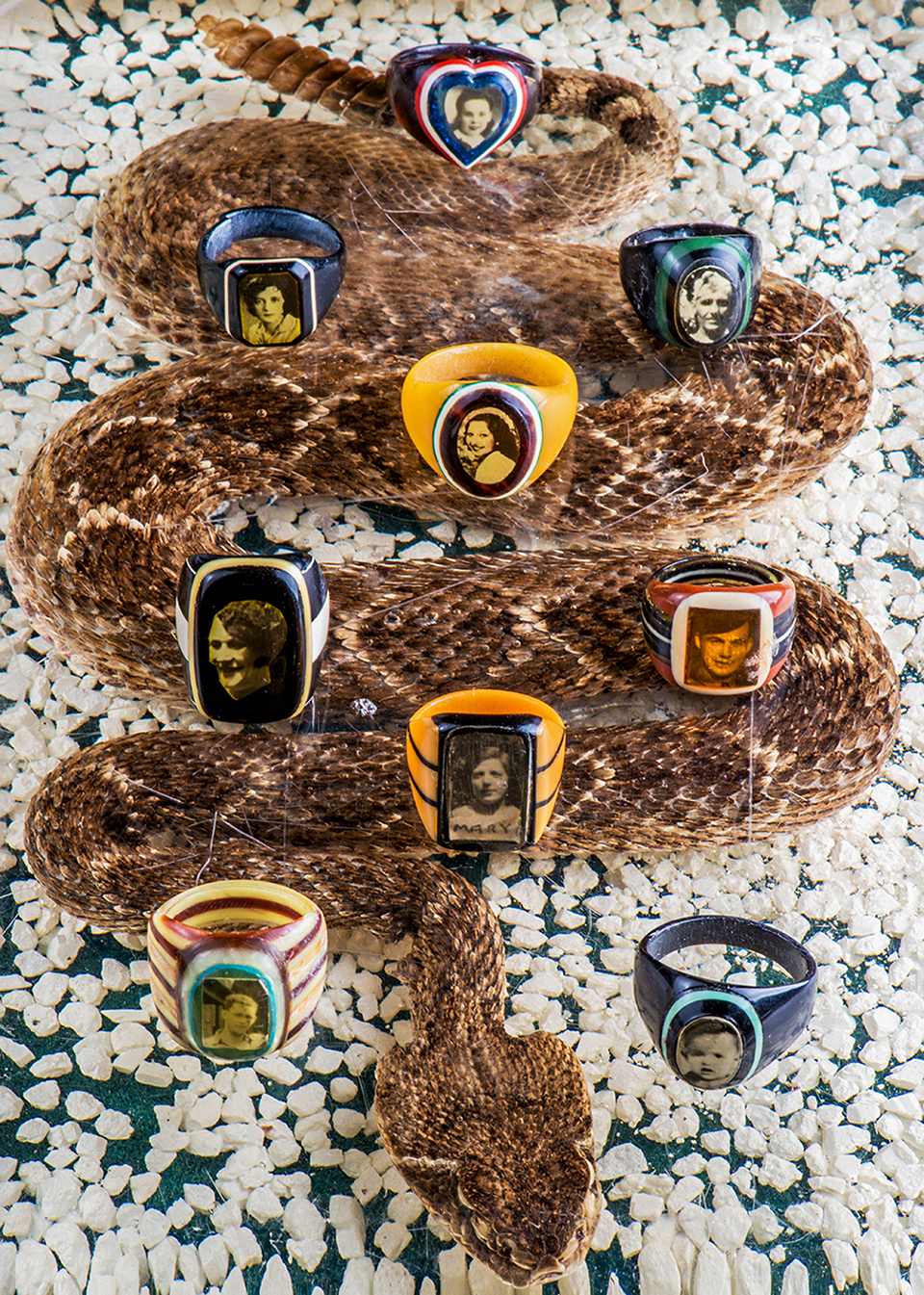
Examples from Strickland’s collection include tributes to children who died as well as “sweetheart” rings and prison rings, which were crafted from Bakelite toothbrushes from behind bars. (Photos by Danny Fulgencio)
She’s so into the rings that she’s tried to make her own, using a silver ring kit and photos of her grandparents.
“If there was a way I could bring it back, I would,” she says.
It’s her love of old photographs and the stories behind antiques that fueled the obsession.
“I hate that people would not pass that down,” she says. “That would be the thing I would most want in the world. I guess there was no family left who wanted them.”
She’s bought mourning rings where the photos have faded completely because she still feels for the objects and doesn’t want them to be unappreciated.
Now she only buys the very rare ones, like the one of a little boy with butterfly wings inside the ring and one with a red-white-and-blue heart.
Sometimes she gives them away to friends who really fall in love with one. And she usually raffles one off at her annual Christmas party.
“I like people to celebrate death, and I think we’ve lost that now,” she says. “We didn’t take everything for granted, and people did nice things for each other.”

